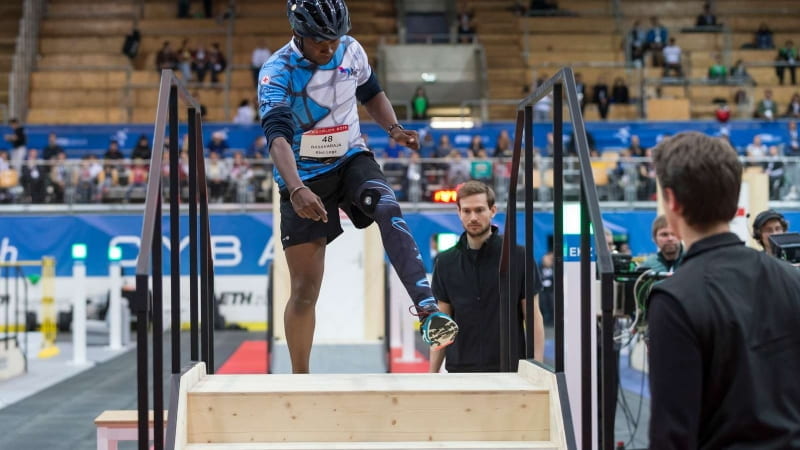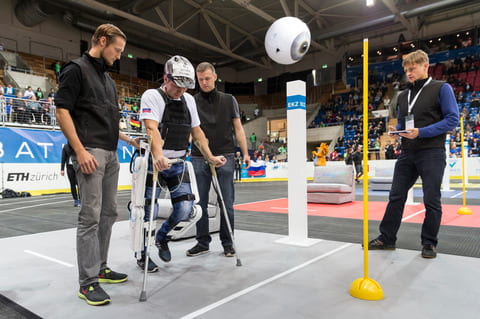THE CYBATHLON: THE OLYMPICS OF RESTORING DAILY TASKS
By: Eric Earley

The 2016 Summer Olympic Games were a chance to celebrate the world’s greatest athletes, who strive to constantly push the boundaries of what the human body is capable. As a biomedical engineer, I can fully appreciate the pinnacle of fitness these athletes have achieved and the amazing biomechanical processes that go into each event.
However, I find myself equally spellbound by Paralympic athletes and their ability to surmount their perceived limitations and continually advance themselves. If you haven’t seen it, I highly recommend watching UK Channel 4’s Paralympics advert, which does an incredible job of showing how Paralympic athletes are able to lead full and active lives.
These athletes are incredibly skilled and have trained hard for years to become world-class athletes. But a physical limitation, like missing a limb or being paralyzed from the waist down, also makes everyday tasks more complicated. People with disabilities can’t eat, work, or clothe themselves the same way as someone able-bodied does, so they’ve adapted the way they perform these daily activities.
There’s not just one way to adapt to a disability, either. Paralympic athletes use a wide range of prostheses, wheelchairs, and other devices, while some may choose to not use a device at all. However, all devices used in Olympic competition must be completely passive: Paralympic regulations prohibit the use of powered or robotic devices in order to ensure a level playing field. This naturally leads me to wonder, how might things change if these advanced devices were allowed? Enter: The Cybathlon.
The Cybathlon is a mixture of the Paralympics and a robotics competition. According to their website, the Cybathlon was created to achieve three goals:
- facilitate conversation between academia and industry,
- facilitate discussion between technology developers and those who would use their technology, and
- to promote the use of robotic assistive aids.
It is a competition of not only the athletes, or “drivers”, but also the teams of engineers and clinicians that create state-of-the-art robotic and rehabilitation devices. Researchers and patients work together to restore daily functionality, including navigating stairs, opening doors, balancing on beams, manipulating clothespins, and racing bicycles with a debilitating spinal cord injury (by electrically stimulating the leg muscles to use the pedals).
Many able-bodied people take the simplicity of these tasks for granted, but breaking down the intricate and dexterous movements that are required reveals their hidden complexity. Opening a door might not be given a second thought for an able-bodied person, but how would someone in a wheelchair open a door? (To pull, first rotate the chair slightly sideways so pulling on the door doesn’t rotate the wheelchair away from the opening. To push, hold the door with one hand and push the chair’s opposing wheel with the other to avoid rolling back.)
What about someone using a prosthetic hand? (If they can, they will use their non-amputated hand to open the door. Otherwise, they will try to push the door handle without opening the prosthetic hand, rather than grabbing the door handle, which can be a cumbersome task.) An exoskeleton? (Most exoskeletons require crutches for stability, so the user has to let go of one crutch to open the door.)
Even though the function is the same – opening a door – the experience and hurdles are different for different types of users, and therefore requires different solutions. Thinking through these tasks can lead to a greater appreciation for how able bodies move and all they’re capable of, but also helps us to create better devices to help people with mobility challenges.

Rise Legs competing at Cybathalon 2016 Photo credit: ETH Zürich/Alessandro Della Bella/
One of my favorite teams from this year’s Cybathlon was Rise Legs, one of the few teams that didn’t use robotic components in their device. Rise Legs are passive prosthetic legs inspired by cane furniture; cane is a very sturdy material with enough flexibility to act like a stiff spring, which is exactly what prosthetic legs aim for. These legs can be designed cheaply and quickly, which makes them an appealing alternative for amputees living in India (the team’s home country). For such a simple device, the team’s two drivers completed the entire circuit in the shortest time of any team. Both drivers finished in under a minute!

A powered exoskeleton in competition Photo credit: ETH Zürich/Alessandro Della Bella/
While the devices demonstrated at the Cybathalon are major achievements in prosthetic and rehabilitation design, they are also feats of mastery for the drivers. Some interfaces require rigorous training to master. Controlling a computer game using brain signals (such as EEG) requires incredible finesse in generating specific and consistent brain patterns, which can take weeks to learn, or longer!
In much the same way as Olympians and Paralympians dedicate years honing their skills and perfecting their craft, patients who compete at the Cybathlon put in many, many hours learning to use the devices and providing feedback to researchers. With the time required to learn these new and advanced devices, however, many patients are hesitant to switch from their current device.
Clinicians and users have many questions to answer when deciding what device works best for their needs. Should an amputee use a passive prosthesis with no robotic components, like those Paralympic athletes use in competition and daily life? Or would they be better off with a robotic prosthesis with state-of-the-art technology, which may have great benefits but require dedicated training and a long learning curve to use effectively? Perhaps, they might even prefer to have no prosthesis at all if, for example, they find wearing a prosthetic socket uncomfortable.
When it comes to prosthetics, there is no one-size-fits-all solution. Every device has its benefits and trade-offs. The Cybathlon showcased the current limits of technology and how researchers and engineers are working with patients to develop creative, new solutions and to grow the field as a whole.
The competition showcased innovative and state-of-the-art rehabilitative devices and how their designers addressed the daily tasks we take for granted. It was an opportunity to see how far rehabilitation technology has come, and with the next Cybathlon scheduled for 2020, I am looking forward to the progress we will make over these next few years.
